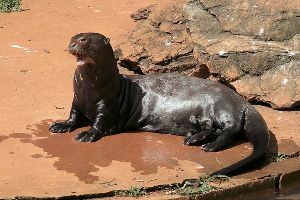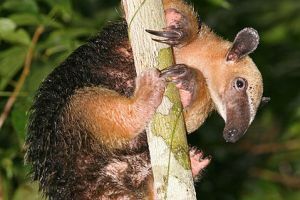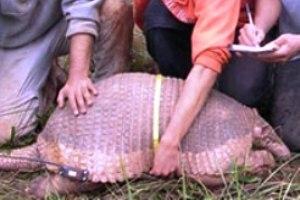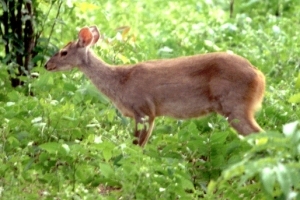The Cerrado is a predominant vegetation in a large part of the Brazilian territory. It used to occupy a quarter of the country's area, covering ten states, but today less than 20% of that total remains.
The presence of the three hydrographic basins, which are the largest in South America, Tocantins-Araguaia, São Francisco and Prata, favor the biodiversity of fauna and flora.
Based on these data, we will restrict the focus of observation and analysis in the zoogeography of the Cerrado, that is, the faunal potential of this fantastic domain.
Below we will see a series of mammalian animals that transit in the various subsystems of the Cerrado:
Tapir (Tapirus terrestris)
Adult weight between 140 and 250 kg, it is present in all Cerrado subsystems, although it is found more frequently in subsystems of paths and marshy environments and riparian forests. According to the International Union for the Conservation of Nature (IUCN), this species is vulnerable (VU, Vulnerable).
Otter (Pteronura brasiliensis)
Adult weight of 20 kg, transits in riparian forest. According to the IUCN, it is in danger (EM, Endangered).
Howler monkey or howler monkey (Alouatta caraya)
Adult weight: 8 to 10 kg. It presents itself in the riparian forest subsystem. According to the IUCN, it is at minimal risk of extinction (LC, Least Concern).
Bush dog (Cerdocyon thous)
Adult weight: 8 kg. It passes through the field and cerrado subsystem. According to the IUCN, it is also at minimal risk of extinction.
Cangambám or Jaratataca (Conepatus semistriatus)
Adult weight: 1 kg. Transit in the field and cerrado subsystems. Minimal risk of extinction.
Capybara (Hydrochoerus hydrochaeris)
Adult weight: 60 to 70 kg. It appears in the subsystems of footpaths and marshy environments, as well as in riparian forests. Minimal risk of extinction.
Hart (Blastocerus dichotomus)
Adult weight: 100 kg. It is most frequently found in field subsystems, paths and marshy environments, forest and riparian forest. According to IUCN, vulnerable (VU, Vulnerable).
Cuica (Philander opossum)
Adult weight: 4 kg. Transits in all subsystems. Minimal risk of extinction.
Shrimp (Didelphis albiventris)
Adult weight: 1 kg. It passes through the cerradão and kills subsystems. Minimal risk of extinction.
Margay (Leopardus wiedii)
Adult weight: 6 kg. It passes through the forest. According to the IUCN, it is an almost threatened species (NT, Near Threatened).
Moorish cat (cougar yagouaroundi)
Adult weight: 10 kg. It moves along paths and in marshy environments. Minimal risk of extinction.
haystack cat (Leopardus colocolo)
Adult weight: 3 kg. It passes through the cerrado subsystem. Nearly threatened species (NT, Near Threatened).
Irara (barbarian thrashing)
Adult weight: 8 kg. It passes through the forest and riparian forest subsystems. Minimal risk of extinction.
Ocelot (Leopardus sparrow)
Adult weight: 15 kg. It appears in the cerrado, cerradão, forest and riparian forest. Minimal risk of extinction.
Guara wolf (Chrysocyon brachyurus)
Adult weight: 20 kg. It passes through the field, cerrado and riparian forest subsystems. Nearly threatened species (NT, Near Threatened).
Do not stop now... There's more after the advertising ;)
Otter (longicaudis otter)
Adult weight: 10 kg. It passes through the riparian forest. Insufficient data regarding its conservation status (DD, Deficient date).
Naked hand (Procyon cancrivorus)
Adult weight: 15 kg. It passes through the riparian forest subsystem. Minimal risk of extinction.
Jaguar (panthera onca)
Adult weight: 80 to 100 kg. It passes through the cerradão, forest and riparian forest subsystems. Nearly threatened species.
Hedgehog (Coendou prehensilis)
Adult weight: 6 to 8 kg. It passes through the cerradão, woods, riparian forests, paths and marshy environments. Minimal risk of extinction.
Paca (cuniculus paca)
Adult weight: 6 to 8 kg. It passes through the riparian forest subsystem. Minimal risk of extinction.
Wild pig, or peccary (Tayassu peccary)
Adult weight: 35 to 40 kg. It passes through the cerrado, cerradão, forest and riparian forest subsystems. Nearly threatened species.
coati (nasua nasua)
Adult weight: 5 kg. It passes through the cerradão and forest subsystems. Minimal risk of extinction.
Field fox (Pseudalopex vetulus)
Adult weight: 8 kg. Transits in the field subsystem. Minimal risk of extinction.
Puma (Puma concolor)
Adult weight: 60 kg. It is present in the field, cerrado, cerradão, forest and riparian forest subsystems. Minimal risk of extinction.
Giant Anteater (Myrmecophaga tridactyla)
Adult weight: 25 to 30 kg. It passes through a field and cerrado subsystem. Species status: vulnerable.
Little Anteater (Anteater tetradactyla)
Adult weight: 5 to 8 kg. It transits in all subsystems, but presents itself more frequently in the field. Minimal risk of extinction.
Giant Armadillo (Maximus Priodonts)
Adult weight: 30 kg. It is found in the field, cerrado, cerradão and riparian forest subsystems. Species status: vulnerable.
Tatupeba (Euphractus sexcinctus)
Adult weight: 3 to 4 kg. It travels through countryside and cerrado. Minimal risk of extinction.
Armadillo Ball (Tricinctus tolypeutes)
Adult weight: 2 to 3 kg. It passes through the field and cerrado subsystems. Species status: vulnerable.
Chicken Armadillo (Dasypus novemcinctus)
Adult weight: 6 to 8 kg. It passes through the field, cerrado, cerradão and riparian forest subsystem. Minimal risk of extinction.
Soft-tailed Armadillo (Cabassous unicinctus)
Adult weight: 3 kg. It appears in field and cerrado subsystems. Minimal risk of extinction.
Brown deer (Mazama Gouazoubira)
Adult weight: 20 kg. It passes through the cerradão subsystem, it kills and riparian forests. Minimal risk of extinction.
Pampas Deer (Ozotoceros bezoarticus)
Adult weight: 40 to 60 kg. It moves more frequently in the field and cerrado subsystem. Nearly endangered species.
bush deer (american maze)
Adult weight: 25 to 30 kg. It passes through the cerradão subsystem, it kills and riparian forests. IUCN does not have enough data to assess its conservation status - (DD, Deficient date).
Eduardo de Freitas
Graduated in Geography

